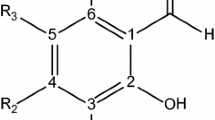Abstract
This study was carried out to determine the antimicrobial activities of leptospermone isolated from Leptospermum scoparium and its derivatives against six foodborne bacteria (Listeria monocytogenes, Salmonella typhimurium, Shigella flexneri, Shigella sonnei, Staphylococcus intermedius and Staphylococcus aureus), with a view to developing safer antimicrobial agents. The essential oil of L. scoparium seeds possessed potent antimicrobial activity against six bacterial strains. The antimicrobial compound of L. scoparium was isolated by chromatographic analyses and identified as leptospermone. To investigate the structure–activity relationships, the antimicrobial activities of leptospermone and its derivatives (2-acetyl-1,3-cyclohexanedione, 1,3-cyclohexanedione, 1,2,3-cyclohexanetrione-1,3-dioxime, 5,5-dimethyl-1,3-cyclohexanedione and 2,2,4,4,6,6-hexamethyl-1,3,5-cyclohexanetrione) were examined against six foodborne bacteria. Based on the MIC values, leptospermone (MIC 23.6–69.7 μg/mL), 1,2,3-cyclohexanetrione-1,3-dioxime (MIC 43.9–88.5 μg/mL) and 2,2,4,4,6,6-hexamethyl-1,3,5-cyclohexanetrione (MIC 43.9–88.5 μg/mL) exhibited antimicrobial activities against the six foodborne bacteria. These results indicated that leptospermone and its derivatives could potentially be developed as natural food preservatives, rather than using hazardous synthetic preservatives.


Similar content being viewed by others
References
Alvarez Costa A, Naspi CV, Lucia A, Masuh HM. Repellent and larvicidal activity of the essential oil from Eucalyptus nitens against Aedes aegypti and Aedes albopictus (Diptera: Culicidae). J. Med. Entomol. 54: 670–676 (2017)
Bhargava K, Conti DS, da Rocha SR, Zhang Y. Application of an oregano oil nanoemulsion to the control of foodborne bacteria on fresh lettuce. Food Microbiol. 47: 69–73 (2015)
Cho M, Ko SB, Kim JM, Lee OH, Lee DW, Kim JY. Influence of extraction conditions on antioxidant activities and catechin content from bark of Ulmus pumila L. Appl. Biol. Chem. 59: 329–336 (2016)
Christoph F, Kaulfers PM, Stahl-Biskup E. A comparative study of the in vitro antimicrobial activity of tea tree oils with special reference to the activity of β-triketones. Planta Med. 66: 556–560 (2000)
Douglas MH, van Klink JW, Smallfield BM, Perry NB, Anderson RE, Johnstone P, Weavers RT. Essential oils from New Zealand Manuka: triketone and other chemotypes of Leptospermum scoparium. Phytochemistry 65: 1255–1264 (2004)
Gyawali R, Ibrahim SA. Natural products as antimicrobial agents. Food control 46: 412–429 (2014)
Hellyer RO. The occurrence of β-triketones in the steam-volatile oils of some myrtaceous Australian plants. Aust. J. Chem. 21: 2825–2828 (1968)
Henriques AF, Jenkins RE, Burton NF, Cooper RA. The intracellular effects of Manuka honey on Staphylococcus aureus. Eur. J. Clin. Microbiol. Infect. Dis. 29: 45–50 (2010)
Kashman Y, Rotstein A, Lifshitz A. The structure determination of two new acylphloroglucinols from Myrtus communis L. Tetrahedron 30: 991–997 (1974)
Kim HJ, Koo M, Hwang D, Choi JH, Kim SM, Oh SW. Contamination patterns and molecular typing of Bacillus cereus in fresh-cut vegetable salad processing. Appl. Biol. Chem. 59: 573–577 (2016)
Kim MG, Lee HS. Insecticidal toxicities of naphthoquinone and its structural derivatives. Appl. Biol. Chem. 59: 3–8 (2016)
Law JWF, Ab Mutalib MS, Chan KG, Lee LH. Rapid methods for the detection of foodborne bacterial pathogens: principles, applications, advantages and limitations. Front. Microbiol. 5: 770 (2015)
Lis-Balchin M, Hart SL, Deans SG. Pharmacological and antimicrobial studies on different tea-tree oils (Melaleuca alternifolia, Leptospermum scoparium or Manuka and Kunzea ericoides or Kanuka), originating in Australia and New Zealand. Phytother. Res. 14: 623–629 (2000)
Perry NB, Brennan NJ, Van Klink JW, Harris W, Douglas MH, McGimpsey JA, Smallfield BM, Anderson RE. Essential oils from New Zealand Manuka and Kanuka: chemotaxonomy of Leptospermum. Phytochemistry 44: 1485–1494 (1997)
Porter NG, Wilkins AL. Chemical, physical and antimicrobial properties of essential oils of Leptospermum scoparium and Kunzea ericoides. Phytochemistry 50: 407–415 (1999)
Reichling J, Koch C, Stahl-Biskup E, Sojka C, Schnitzler P. Virucidal activity of a β-triketone-rich essential oil of Leptospermum scoparium (Manuka oil) against HSV-1 and HSV-2 in cell culture. Planta Med. 71: 1123–1127 (2005)
Sanyacharernkul S, Nantapap S, Sangrueng K, Nuntasaen N, Pompimon W, Meepowpan P. Antifungal of modified neolignans from Mitrephora wangii Hu. Appl. Biol. Chem. 59: 385–389 (2016)
Scallan E, Hoekstra RM, Angulo FJ, Tauxe RV, Widdowson MA, Roy SL, Griffin PM. Foodborne illness acquired in the United States-major pathogens. Emerg. Infect. Dis. 17: 7–15 (2011)
Shan B, Cai YZ, Brooks JD, Corke H. Antibacterial properties and major bioactive components of cinnamon stick (Cinnamomum burmannii): activity against foodborne pathogenic bacteria. J. Agric. Food Chem. 55: 5484–5490 (2007)
Smith-Palmer A, Stewart J, Fyfe L. Antimicrobial properties of plant essential oils and essences against five important food-borne pathogens. Lett. Appl. Microbiol. 26: 118–122 (1998)
Song CY, Nam EH, Park SH, Hwang CY. In vitro efficacy of the essential oil from Leptospermum scoparium (Manuka) on antimicrobial susceptibility and biofilm formation in Staphylococcus pseudintermedius isolates from dogs. Vet. Dermatol. 24: 404-e87 (2013)
van Klink JW, Brophy JJ, Perry NB, Weavers RT. β-Triketones from Myrtaceae: Isoleptospermone from Leptospermum scoparium and papuanone from Corymbia dallachiana. J. Nat. Prod. 62: 487–489 (1999)
van Klink JW, Larsen L, Perry NB, Weavers RT, Cook GM, Bremer PJ, Kirikae T. Triketones active against antibiotic-resistant bacteria: synthesis, structure-activity relationships, and mode of action. Bioorg. Med. Chem. 13: 6651–6662 (2005)
Wilcock A, Pun M, Khanona J, Aung M. Consumer attitudes, knowledge and behavior: a review of food safety issues. Trends Food Sci. Technol. 15: 56–66 (2004)
Acknowledgements
This research was supported by Basic Science Research Program through the National Research Foundation of Korea (NRF) funded by the Ministry of Science, ICT and future Planning (2016R1A2A2A05918651).
Author information
Authors and Affiliations
Corresponding author
Rights and permissions
About this article
Cite this article
Jeong, EY., Lee, MJ. & Lee, HS. Antimicrobial activities of leptospermone isolated from Leptospermum scoparium seeds and structure–activity relationships of its derivatives against foodborne bacteria. Food Sci Biotechnol 27, 1541–1547 (2018). https://doi.org/10.1007/s10068-018-0391-4
Received:
Revised:
Accepted:
Published:
Issue Date:
DOI: https://doi.org/10.1007/s10068-018-0391-4




